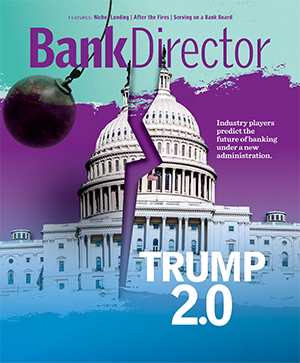
Riding the Wave
Well before discovering his true calling as a private equity fund manager, John Eggemeyer III lived out a full career as a big-bank executive. He was fired from one high-profile job, nudged out of another, and lost a third when his employer collapsed amid scandal. Along the way, Eggemeyer says, he became disenchanted with the suffocating nature of those large organizations. u00e2u20acu0153The emphasis was always on not being wrong, rather than on being right.u00e2u20ac
Today, as head of Castle Creek Capital, Eggemeyer, 60, calls his own shots. His Rancho Santa Fe, California fund manager has carved out a unique niche for itself by rolling up strong community banking franchises in high-growth markets. It has acquired 52 banks since its founding in 1994 u00e2u20ac”the third most of any firm in that time, behind only Wells Fargo & Co. and Regions Financial Corp.
Castle Creek has raised some $380 million in three separate funds and is presently seeking as much as $500 million for a fourth one. The investors in those funds are typically high-net-worth individuals who have at least $1 million to throw in. Perhaps more significant is the willingness of traditional institutional investorsu00e2u20ac”including the likes of Basswood Partners, Burnham Financial Services Fund, and Franklin Mutual Seriesu00e2u20ac”to invest their money alongside Eggemeyeru00e2u20acu2122s funds.
Those investors have fared extremely wellu00e2u20ac”owners of the now-closed first fund more than tripled their money; the second fund is winding down and promises similar returns. So, too, has Eggemeyer, whose reputation as a shrewd dealmaker and strategist willing to take calculated risks in search of better returns has been burnished several times over.
u00e2u20acu0153My dad always said you can tell the skill of a trapper by his pelts,u00e2u20ac says activist investor Ralph Whitworth, founder of Relational Investors, a San Diego investment firm that has worked with Eggemeyer. u00e2u20acu0153Johnu00e2u20acu2122s got a very nice string of pelts.u00e2u20ac
Private equity is all the rage in corporate America today, and its presence in banking is slowly on the rise. Even so, barriers to entry are stiff. Fund managers like controlu00e2u20ac”something thatu00e2u20acu2122s tough to come by in a highly regulated industry. Thatu00e2u20acu2122s why most fund holdings in banks are passive ones, below 9.9% of outstanding stock.
Castle Creek is one of a handful of private equity firms that has gotten around the problem by focusing exclusively on financial services as a bank holding company. That allows it to take a hands-on approach in guiding the strategic course of its investee banks.
u00e2u20acu0153John and his team have very strong opinions about how a bank should be run,u00e2u20ac says Chris Marinac, an analyst with FIG Partners in Atlanta. u00e2u20acu0153Theyu00e2u20acu2122re not passive investors. They jump in with a firm idea of what they think can be improved and donu00e2u20acu2122t stand still for more than 30 seconds.u00e2u20ac
Watching the pipeline
When the price is right, Castle Creek wonu00e2u20acu2122t hesitate to sell. The firmu00e2u20acu2122s biggest score came in 1999, when it cobbled seven banks together into Los Angeles-based Western Bancorp and sold it to U.S. Bancorp for $958 million, quadrupling investorsu00e2u20acu2122 money. In 2006, it sold another roll-upu00e2u20ac”Fort Worth, Texas-based State National Bancsharesu00e2u20ac”to Spainu00e2u20acu2122s Banco Bilbao Vizcaya Argentaria for $480 million, providing a return of 2.5 times the original investment. Both deals fetched about 4.4 times tangible book value.
Yet, Castle Creeku00e2u20acu2122s usual approach is to buy and run the operations for the long haul. The firmu00e2u20acu2122s biggest holding, $5.3 billion First Community Bancorp in southern Californiau00e2u20ac”one of the Golden Stateu00e2u20acu2122s largest remaining independentsu00e2u20ac”has been a rumored takeout candidate for years. Yet Eggemeyer, First Communityu00e2u20acu2122s chairman, says thereu00e2u20acu2122s little pressure to sell. The original investors put up $3.40 per share 12 years ago; today, the stock trades around $55. u00e2u20acu0153Itu00e2u20acu2122s paying a $1.28 annual dividend. Thatu00e2u20acu2122s a 40% yield on that original investment. No one is complaining.u00e2u20ac
Similar long-term thinking governs Castle Creeku00e2u20acu2122s other holdings. u00e2u20acu0153If you donu00e2u20acu2122t run a company like itu00e2u20acu2122s yours forever, youu00e2u20acu2122ll cut corners, and when you hit a difficult operating environmentu00e2u20ac”like the one weu00e2u20acu2122re in nowu00e2u20ac”the things you didnu00e2u20acu2122t do will come back to haunt you,u00e2u20ac Eggemeyer says.
Castle Creek presently controls five banking companies with $10 billion in combined assets. Two of thoseu00e2u20ac”First Community in San Diego and $2.76 billion Centennial Bank Holdings in Fort Collins, Coloradou00e2u20ac”are publicly traded and feature Eggemeyer as chairman.
The other three are private for now, including $1.1 billion First Chicago Bancorp and smaller operations in Atlanta, ($112 million Atlanta Bancorp), and central Florida ($614 million The BANKshares, in Melbourne). The objective is to build up those franchises through acquisition and eventually take them public, providing both an exit for investors who want it and a currency to do more deals.
u00e2u20acu0153For most private equity funds, when their portfolio companies go public, thatu00e2u20acu2122s the end of the investment,u00e2u20ac Eggemeyer says. u00e2u20acu0153For us, itu00e2u20acu2122s really the beginning.u00e2u20ac
The firmu00e2u20acu2122s funds also own stakes in a smattering of other financial services firms, such as White River Capital, an Indianapolis-based indirect auto lender, where Eggemeyer also wears the chairman hat.
A separate arm of the firm, Castle Creek Financial, advises financial institutions (including its own) on M&A and other strategic matters. Eggemeyer served as confidant to Whitworth in his high-profile clash with Sovereign Bancorp and its former CEO, Jay Sidhu. Relational took an 8% stake in Sovereign in 2005 and began agitating for board and management changes, which eventually ended with Sidhuu00e2u20acu2122s ousting and 24.9% of the Philadelphia thrift being sold to Spainu00e2u20acu2122s Banco Santander Central Hispano.
u00e2u20acu0153I wanted outside validation of our investment thesis before we launched into an escalated phase of the engagement,u00e2u20ac recalls Whitworth, who now sits on Sovereignu00e2u20acu2122s board. Eggemeyer u00e2u20acu0153took on the role of a senior sageu00e2u20ac”a wise man who could help me with contacts and understanding the dynamics of the industry.u00e2u20ac
Occasionally, Castle Creek plays the role of matchmaker between investors and bank clients. In 2004, the firm helped Hanmi Financial Corp., a Korean-American bank in Los Angeles, raise $100 million in three weeks to acquire in-market competitor Pacific Union Bank. u00e2u20acu0153They didnu00e2u20acu2122t have a track record of acquiring or consolidating institutions, and they didnu00e2u20acu2122t have a name that was capable of raising money,u00e2u20ac explains Castle Creek co-founder and principal William Ruh, 46, who joined Hanmiu00e2u20acu2122s board as part of the deal.
Those investors have mostly departed now, and Ruh recently stepped down from the board. u00e2u20acu0153We took the board seat to manage the process and drive the company toward enhanced profitability over the years our investors were involved,u00e2u20ac he says.
Such activities merely supplement the core business of buying and building community banking franchises. Eggemeyer and his partners are seasoned bankers with definite ideas about how to wring the most profits possible out of a bank. In all of their holdings, they introduce a formulau00e2u20ac”rooted in capturing low-cost deposits, lending conservatism, and expense controlsu00e2u20ac”utilizing the teamu00e2u20acu2122s expertise to implement key changes.
u00e2u20acu0153We have operational expertise, tax and accounting expertise, credit and treasury expertise. Most every function a bank would face, someone on our team has experience in,u00e2u20ac Ruh says.
The process begins by selecting a core bank in a high-growth area thatu00e2u20acu2122s ripe for consolidation. u00e2u20acu0153We want to be in markets that are growing faster than the economy as a whole, and we want to be in markets that are fragmented, so we can build a large-scale operation,u00e2u20ac Eggemeyer explains.
Those franchises are grown via acquisitions, with an emphasis on targets with good management teams and, when possible, high levels of non-interest-bearing deposits. The 15 banks acquired to build First Community boasted average non-interest-bearing deposits of 26% when they were bought, Eggemeyer says. That compares to an industry average of about 18%.
Pricing is important, but Castle Creek isnu00e2u20acu2122t shy about paying up. When $709 million Centennial went on the sales block in 2004, most of the big banks active in Colorado took a look. Castle Creeku00e2u20acu2122s interest was a surprise. u00e2u20acu0153I was skeptical,u00e2u20ac recalls then-Chairman William Farr. u00e2u20acu0153I had never heard of them before, and really expected to sell to an established bank.u00e2u20ac
When the preliminary bids came in, however, Castle Creeku00e2u20acu2122s $150 million cash offer was the highest. Centennialu00e2u20acu2122s board opened its books to Eggemeyeru00e2u20acu2122s firm and another contender, a regional bank. After the examination, Castle Creek tacked on another $5 million to its bid. u00e2u20acu0153It showed they really wanted us,u00e2u20ac says Farr, 68, who remains on Centennialu00e2u20acu2122s board.
More important is a willingness by the selleru00e2u20acu2122s directors and top executives to use Castle Creeku00e2u20acu2122s strategic playbook. Marinac says Eggemeyer is u00e2u20acu0153like a coach who needs players that will listen to and respond to his philosophy. u00e2u20acu00a6 Some boards and managements can feel threatened by that.u00e2u20ac
Once in the fold, acquireesu00e2u20acu2122 balance sheets and strategies are overhauled. Low-cost funding is ratcheted up, risky loans are whittled down, and cost structures are streamlined.
The firm scientifically models things like u00e2u20acu0153the elasticity of deposit-pricing decisions,u00e2u20ac Eggemeyer says. Using readily available industry statistics, u00e2u20acu0153you can see at any time where you rank among your competitors and say, u00e2u20acu02dcIf Iu00e2u20acu2122m in the 75th percentile in rates today, and I move down to the 65th percentile, hereu00e2u20acu2122s what will happen to my deposit flows.u00e2u20acu2122u00e2u20ac Itu00e2u20acu2122s not unusual for Castle Creek to subtly u00e2u20acu0153chase awayu00e2u20ac higher-cost CD customers as part of the process, replacing them with small-business and middle-market clients, who value service over price.
Incentives are part of the process, as well. Loan officers receive commission-type rewards tied to the levels of demand deposits they attract from clients, Farr says. Oftentimes, maintaining operational deposit accounts with the bank is a condition of a loan.
At the same time, lending activity is scaled backu00e2u20ac”particularly in areas such as commercial real estate. As Eggemeyer sees it, lower-cost funding trumps rapid asset growth as a way to grow earnings. u00e2u20acu0153You canu00e2u20acu2122t have a high net-interest margin without having either a very low cost of money or taking on inordinate risk on the asset side.u00e2u20ac He believes the former is less risky.
A keen eye for management
With banks everywhere feeling the pressure of the inverted yield curve and margin compression, Castle Creeku00e2u20acu2122s strategy is looking especially shrewd. First Communityu00e2u20acu2122s net-interest margin declined 19 basis points in the first quarter of this year, reflecting the industryu00e2u20acu2122s troubles. Even so, it still stood at a whopping 6.33%u00e2u20ac”one of the highest margins for any bank, period.
u00e2u20acu0153The biggest operational takeaway for boards in what Castle Creek does is that you need to manage the net-interest margin on both sides of the balance sheet,u00e2u20ac says Steve Nelson, a principal with Hovde Financial LLC in Chicago. Hovde has sold several banks to Castle Creek. u00e2u20acu0153For most banks, itu00e2u20acu2122s all about lending or credit. These guys flip that on its head.u00e2u20ac
The third leg of the strategy centers on expense controls. First Chicago, a combination of three Chicagoland banks, has slashed total employment from 160 to 106, Ruh says.
Castle Creek doesnu00e2u20acu2122t make such cuts haphazardly. The firm pays special attention to such nuances as u00e2u20acu0153how we staff tellersu00e2u20ac”the times of day they work, the times they get lunch breaks, what hours the branches are open, and how many people count cash in a day,u00e2u20ac Ruh explains. u00e2u20acu0153We change the business practices and workflows in the organization.u00e2u20ac
The firm gains extra savings by leveraging its buying power to renegotiate the terms of vendor contracts. At First Chicago, u00e2u20acu0153virtually every contractu00e2u20ac has been reworked, Ruh says, saving plenty of money. In the process, the banku00e2u20ac”anticipating further growthu00e2u20ac”has created a technology platform capable of supporting a mid-sized bank.
Being part of this loose-knit confederation of banks brings advantages an independent bank lacks. Since they share the same core strategic objectives, Eggemeyer encourages executives to share experiences and insights with each other.
u00e2u20acu0153My CFO at First Chicago will call his counterpart at First Community on a regular basis,u00e2u20ac Ruh explains. u00e2u20acu0153Heu00e2u20acu2122ll say, u00e2u20acu02dcIu00e2u20acu2122ve got an appraisal issue related to property, plant, and equipment, or some goodwill to handle from an acquisition. How would you handle this?u00e2u20acu2122u00e2u20ac
Sometimes, the sharing is more formalized. Centennial, for instance, signed a consulting agreement with First Community shortly after it was acquired, paying its partner bank to help with strategic implementations. That contract has since expiredu00e2u20ac”largely because a First Community executive moved to Colorado, and now works for Centennial.
Thereu00e2u20acu2122s some cross-pollination at the board level, as well. First Community CEO Matthew Wagner and Kathleen Smythe, a former managing director at investment bank Keefe Bruyette & Woods and longtime Eggemeyer friend, sit on the Centennial board. Wagner, in particular, is u00e2u20acu0153very vocal with ideas he thinks can help improve the bank,u00e2u20ac Farr says. Likewise, M. Christian Mitchell, a former managing partner with Deloitte & Toucheu00e2u20acu2122s financial services group, is a director on First Chicagou00e2u20acu2122s board.
Empowering leaders
That national expertise is backed by local know-howu00e2u20ac”much of it added by Eggemeyeru00e2u20acu2122s team. First Chicagou00e2u20acu2122s board includes Lowell Stahl, former chairman of Labe Bank, Castle Creeku00e2u20acu2122s first acquisition in Chicago. Over time, heu00e2u20acu2122s been joined by a cast of newcomers, including Patrick Arbor, former chairman of the Chicago Board of Trade, Jim Goodwin, former chairman and CEO of United Airlines, and longtime Chicago banker John W. Rose, among others.
u00e2u20acu0153At the end of the day, weu00e2u20acu2122re successful because we put the right people in place and empower them,u00e2u20ac Eggemeyer says. u00e2u20acu0153If we donu00e2u20acu2122t let them make the decisions, then weu00e2u20acu2122re not going to develop leadership.u00e2u20ac
The boards arenu00e2u20acu2122t exactly puppets of the firm. Eggemeyer says directors are relied upon to provide needed governance, business connections, and day-to-day oversight on weighty matters such as loan approvals. As the organizationu00e2u20acu2122s chief tone setters, perhaps their most important initial role lies in embracing and promoting the strategic vision. u00e2u20acu0153Weu00e2u20acu2122ve walked away from deals that looked attractive, but where we had a disconnect, strategically or ethically, with management or the board,u00e2u20ac he explains.
As with other community banks, local board members are expected to help attract investors and business. Arbor, 70, interrupted a recent interview with a reporter to alert First Chicago President John Eck to a $600,000 loan needed by an acquaintance. u00e2u20acu0153Iu00e2u20acu2122ve probably brought about
$6 million [of investments] into this bank from friends, and I want it to do well,u00e2u20ac he says. u00e2u20acu0153Iu00e2u20acu2122m always trying to bring in new business.u00e2u20ac
All five banking franchises boast Castle Creek principals as chairmen: Eggemeyer in California and Colorado, Ruh in Chicago, and Mark Merlo, a senior vice president and operations guru with 21 years of banking experience, in Atlanta and Florida.
That leadership is more subtle than heavy-handed. Farr says that while Eggemeyer is in Denver to run all Centennial board meetings, u00e2u20acu0153he doesnu00e2u20acu2122t talk a lot.u00e2u20ac In a recent board discussion, Eggemeyer offered some pointed views on the companyu00e2u20acu2122s direction. u00e2u20acu0153But we had to ask him first,u00e2u20ac Farr says. u00e2u20acu0153He doesnu00e2u20acu2122t push things on us.u00e2u20ac
Even so, when it comes to long-term strategy, thereu00e2u20acu2122s little doubt that Castle Creek holds the reins. The Chicago market, for instance, has some 225 independent banks. With competition so stiff, acquisitions are expected to fuel much of First Chicagou00e2u20acu2122s growth.
Arbor says he and fellow board members help make introductions to some of those banks, and frequently offer their thoughts on the market. u00e2u20acu0153But at the end of the day, any decision will be made based on Castle Creeku00e2u20acu2122s analysis,u00e2u20ac he says. The firm u00e2u20acu0153is clearly the boss. The line of authority ends with them, as it should,u00e2u20ac Arbor adds. u00e2u20acu0153They have the controlling block of shares and a lot more on the line than any of us.u00e2u20ac
Rise to the top
A modest midwesterner with a passion for banking, Eggemeyer describes Castle Creeku00e2u20acu2122s success as a team effort that involves hard work from the firmu00e2u20acu2122s principals and staff, as well as the personnel of individual banks. While thatu00e2u20acu2122s certainly true, thereu00e2u20acu2122s no denying that Eggemeyer and the lessons heu00e2u20acu2122s learned over a lifetime of banking have a strong influence on the firm and its holdings.
Ruh describes Eggemeyer as a mentor who is u00e2u20acu0153terrific at critical thinking and problem solving. He attacks a problem by looking at it from all sides and always seems to come up with an optimal solution.u00e2u20ac Adds Whitworth: u00e2u20acu0153Johnu00e2u20acu2122s got a very agile, machine gun mind. Heu00e2u20acu2122s very, very quick, and is able to see the salient points in an issue almost immediately.u00e2u20ac
A deft personal touch balances that sharpness. Whitworth first got to know Eggemeyer several years ago when the two worked together in support of a contentious school bond initiative in Rancho Santa Fe, where they were neighbors. u00e2u20acu0153Thereu00e2u20acu2122s nothing like local politics to bring out peopleu00e2u20acu2122s emotions,u00e2u20ac Whitworth says. u00e2u20acu0153But John always retained a cool head and his good sense of humor. He was a diplomat.u00e2u20ac
A high school offensive lineman in Richmond, Indiana, a town reminiscent of a Norman Rockwell painting, Eggemeyer went to Northwestern University on a football scholarship. He was set to be an assistant on legendary coach Bo Schembechleru00e2u20acu2122s staff at the University of Miami-Ohio when his draft number came up. After Eggemeyer completed three months of basic training at Fort Bliss in 1968, Schembechler had moved on to Michigan.
Fate brought him to a job at the old First National Bank of Chicago, where he spent eight years. In 1977, he landed a finance gig at Northwestern National Bank in Minneapolis (predecessor to Norwest Corp.) and then went on to Chemical Bank in New York, but only stayed 15 months. u00e2u20acu0153My family hated New York,u00e2u20ac he says.
In 1983, he became CEO of First National Holdings, then the biggest bank in Denver. The company was loaded with bad loans, and regulators wanted to shut it down. Eggemeyer devised a plan to resuscitate the bank by stripping capital out of 15 sister banks, wiping the balance sheet clean, boosting loan-loss reserves, firing half the work force, and taking a big restructuring charge.
The next year, well before M&A had become part of the industry landscape, he sold First National to the old First Interstate Corp. for a nice premium. u00e2u20acu0153I found myself on a high wire without a net,u00e2u20ac he recalls. u00e2u20acu0153Everyone around me said we would fail, but to me it was very easy to see what needed to be done, and then to do it.u00e2u20ac
After being nudged out in Denver, he returned to Minneapolis to run trust and investment management for the old First Bank System. The experience of being his own boss had been too liberating, however, and he was dismissed after continually butting heads with his superiors. His next job, as head of bank restructurings for investment bank Drexel Burnham Lambert, ended in 1989 when the firm went bust amid scandal.
Out of work again, just as the thrift crisis was heating up, Eggemeyer says he felt vulnerable. u00e2u20acu0153I had no money. My income was cut off, and there were no real jobs in banking,u00e2u20ac he recalls. u00e2u20acu0153I was not feeling very good about myself, and had a certain amount of insecurity about supporting my family.u00e2u20ac
Left with few alternatives, Eggemeyer set off on his own, printing up business cards at Kinkou00e2u20acu2122s and tapping some of the connections heu00e2u20acu2122d made at Drexel. Among them: United Postal Bank, a troubled mutual thrift in St. Louis, which he signed on to restructure and convert into a public company.
It was a tall order, but he was able to leverage some valuable investor contactsu00e2u20ac”including noted investors Harry Keefe of Keefe Managers and Franklin Mutual Seriesu00e2u20acu2122 Michael Priceu00e2u20ac”and essentially managed the conversion himself. u00e2u20acu0153The plan worked beautifully, the [post-conversion] stock took off, and 15 months later we sold the company for 6.4 times the IPO price,u00e2u20ac he recalls.
A year later, Eggemeyer recapitalized Lafayette American Bank, a thrift in Bridgeport, Connecticut in similar fashion, and then moved to California, home to a host of troubled institutions at the time. He recapitalized three small banks, using funding from the Keefes and Prices of the world, before choosing one to form the foundation for Western.
Around that time, John Rose, now a First Chicago director, convinced him to dip his toe into private equity, and Castle Creek was born. As the industry returned to health and the M&A market blossomed, Eggemeyer shifted his attention from turnarounds to roll-ups. The rest, as they say, is history.
A model that works
Castle Creeku00e2u20acu2122s success has made Eggemeyer a sought-after commodity on boards. He recently stepped down as a director at $13 billion TCF Financial Corp. in Minneapolis and served on the board of American Financial Realty Trust, a REIT that leases office space to financial institutions.
The firmu00e2u20acu2122s model, meanwhile, is becoming more widely studied by others looking for a private equity foothold in the industry. u00e2u20acu0153Weu00e2u20acu2122ve looked at what theyu00e2u20acu2122ve done quite closely,u00e2u20ac says Jody Grant, chairman and CEO of Texas Capital Bancshares in Dallas, and a founder of BankCap Partners I, a recently launched private equity play.
Imitation might be the sincerest form of flattery, but Eggemeyer is the first to admit that Castle Creek has made its share of poorly timed or ill-chosen acquisitions, though it always seems to land on its feet.
Perhaps its biggest stumble came in the early 2000s, when it purchased Coastal Credit, a subprime auto lender in Virginia Beach, Virginia. The investment was a winner, and Castle Creeku00e2u20acu2122s principals thought they could duplicate the success by buying Union Acceptance Corp., a troubled near-prime auto lender in Indianapolis that was 40 times Coastalu00e2u20acu2122s size.
Union Acceptance, already in need of recapitalization, ran into credit problems, which were exacerbated by the post-Sept. 11, 2001 liquidity crunch. Matters werenu00e2u20acu2122t helped when the market for used cars tanked. u00e2u20acu0153It was the perfect storm in auto finance,u00e2u20ac Ruh recalls. u00e2u20acu0153The timing couldnu00e2u20acu2122t have been much worse.u00e2u20ac
The finance company filed for bankruptcy protection, and Castle Creek commenced a complicated transaction that ultimately led to a marriage with Coastal Credit under the White River Capital holding company umbrella. Ruh is president of White River.
Publicly traded White River reported a profit of $7 million in the first quarter, and Ruh predicts Castle Creek will recoup its investment in about two more years. u00e2u20acu0153For us, that would be a huge win,u00e2u20ac he says.
The latest challenge, the firmu00e2u20acu2122s Centennial franchise, is a rare stumble in the banking arena. The troubles began when, two months after the Centennial deal closed, Castle Creek inked a $365 million deal for Guaranty Corp., a $1.4 billion bank in Denver.
The deal was understandable, given the firmu00e2u20acu2122s approach. As Farr, the former Centennial chairman, explains, u00e2u20acu0153If you want to build a strong franchise in Colorado, you need a Denver presence.u00e2u20ac Even so, problems quickly emerged.
For starters, the combined company had too many construction loans. In the tough rate environment, many clients paid off their loans, throwing the balance sheet out of alignment.
Worse were the cultural issues. Guaranty, based along Denveru00e2u20acu2122s 17th Street financial district, was relatively blue blood, and clashed with Centennialu00e2u20acu2122s Old West mentality. u00e2u20acu0153In Fort Collins, the bankers wore cowboy boots, leather bomber jackets, and cowboy hats. The Denver guys wore navy-blue suits with white shirts,u00e2u20ac Eggemeyer says. u00e2u20acu0153They couldnu00e2u20acu2122t see eye to eye on anythingu00e2u20ac”it didnu00e2u20acu2122t matter what the issue was. They couldnu00e2u20acu2122t agree where to go to lunch or what time to eat.u00e2u20ac
As the bigger institution, Guarantyu00e2u20acu2122s management took control, and one of its executives moved to Fort Collins, about an hour north of Denver. During the integration, the two sides struggled over everything from product offerings to technology platforms and benefits providers. u00e2u20acu0153Itu00e2u20acu2122s tricky combining all those things,u00e2u20ac Farr says.
Eventually, Centennial lost several of its best lenders, Farr says, u00e2u20acu0153because they werenu00e2u20acu2122t comfortable with the new structure.u00e2u20ac While a slowing economy hurt performance, u00e2u20acu0153some of the problems came because we lost these good peopleu00e2u20ac who were better at landing and underwriting high-quality loans.
In the first quarter of 2007, net income was 23% lower than a year earlier, while nonperforming loans jumped 12%. Centennial u00e2u20acu0153is a little sick and wounded right now,u00e2u20ac Farr says, adding, u00e2u20acu0153The biggest surprise is that things havenu00e2u20acu2122t gone better. The deal had such a good feel to it at the beginning, but things didnu00e2u20acu2122t work right.u00e2u20ac
In May 2006, Guarantyu00e2u20acu2122s management departed, and Dan Quinn, 50, a director and former head of U.S. Bancorpu00e2u20acu2122s Colorado operations, was named CEO and charged with fostering an entirely new cultureu00e2u20ac”this one rooted in big-bank processes learned at his former employer. Heu00e2u20acu2122s brought in new executives and u00e2u20acu0153lowered the level of rhetoric and tension in the company,u00e2u20ac Eggemeyer says, chalking up the misstep as a learning experience.
u00e2u20acu0153We probably should have been more sensitive to radical differences of the two banks. The incumbents didnu00e2u20acu2122t have the ability to broker a new culture,u00e2u20ac he says. u00e2u20acu0153This has been very hard. But weu00e2u20acu2122re trying to be entrepreneurial and take some measured risks. u00e2u20acu00a6 When you do that, it increases the likelihood that something wonu00e2u20acu2122t work the way you envisioned.u00e2u20ac
Eggemeyer says such situations are where a board can prove its ultimate worth. u00e2u20acu0153In the final analysis, a board is really a crisis management teamu00e2u20ac that needs to be both u00e2u20acu0153composed and skilled enoughu00e2u20ac”with a strong intellectual and ethical coreu00e2u20ac”to operate and function like a team [during] a crisis.u00e2u20ac
The good news is that Castle Creek went through similar travails in the early 2000s with State National Bancorp, and wound up generating big returns for investors. Thatu00e2u20acu2122s good enough for folks like Arbor, who, though he technically has no ties to the Colorado operations, recently bought Centennial shares on the open market. u00e2u20acu0153Iu00e2u20acu2122ve seen these guys in action, and think theyu00e2u20acu2122re good,u00e2u20ac he explains. u00e2u20acu0153I want to invest with them.u00e2u20ac
That intangibleu00e2u20ac”a sense of confidence, derived from years of experienceu00e2u20ac”ultimately may be Castle Creeku00e2u20acu2122s greatest strength. As Eggemeyer and his team look to the future, they envision more dealsu00e2u20ac”potentially lots of themu00e2u20ac”in both existing markets (including Colorado) and new ones.
Ruh says heu00e2u20acu2122d like to at least triple the size of First Chicago within five years. Similar, if not more ambitious, plans are in store for Atlanta and Florida, and the firm is eyeing as many as 50 new markets for potential expansion, including the Pacific Northwest and Texas. u00e2u20acu0153Weu00e2u20acu2122d love to get back into Texas,u00e2u20ac he says.
As in the past, thereu00e2u20acu2122ll be no rushu00e2u20ac”either to buy or sellu00e2u20ac”and a willingness to take chances and weather mistakes. Eggemeyer wouldnu00e2u20acu2122t have it any other way.

Join OUr Community
Bank Director’s annual Bank Services Membership Program combines Bank Director’s extensive online library of director training materials, conferences, our quarterly publication, and access to FinXTech Connect.
Become a Member
Our commitment to those leaders who believe a strong board makes a strong bank never wavers.

